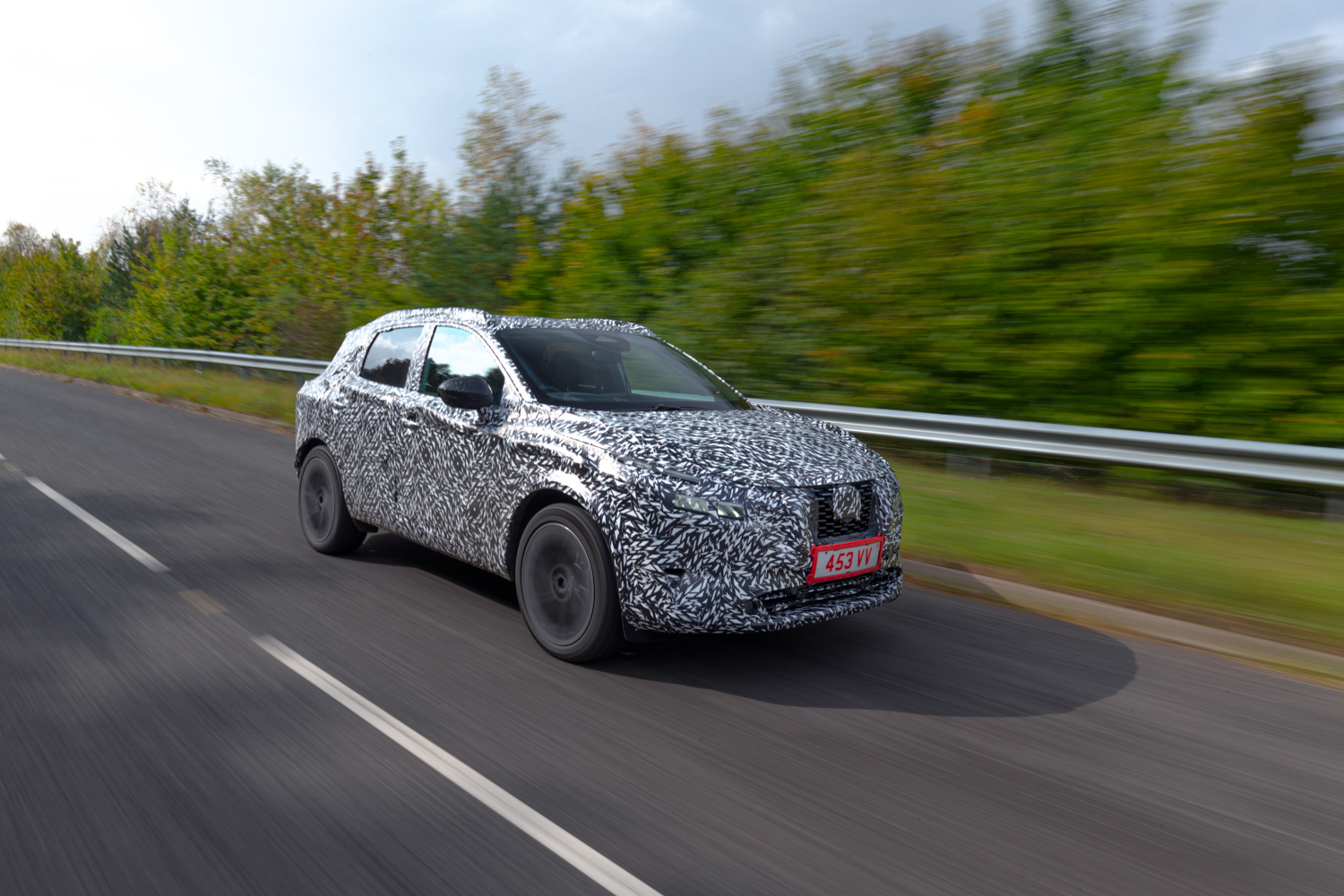Nissan says that it's new Qashqai has 'broken cover' but that's not really quite the case. What we have here are some official 'spy' shots of prototype versions of the new Qashqai strutting their stuff under heavy camouflage.
Well, not THAT heavy - we can see through the tape that while the third generation Qashqai will keep, mostly, the silhouette of the current model, the detailing at the front looks to skew closer to that of the new Juke, so you can expect styling that's a little more distinctive this time around.
"The new Qashqai is going to change what customers can expect from a family car. Comfort, refinement and technology will be from higher categories of car, while the driving experience will satisfy drivers and passengers alike. With Nissan's bold e-POWER technology, we feel that customers will fall in love with the feeling of an electric powertrain, without the range concerns," said Gianluca de Ficchy, Chairman, Nissan Africa, Middle East, India, Europe and Oceania (AMIEO) Region.
The new Qashqai will be the first model from the Renault-Nissan Alliance to use the new CMF-C platform, and Nissan says that there will be some significant weight savings from the switchover. For example, the rear hatch will from now on be made of a plastic composite which saves 2.6kg all by itself.
Nissan is also using much more high-strength steel in the Qashqai's chassis and body, which should improve both safety and stiffness, but theoretically with no weight penalty. Some structural bonding (which means high-strength aviation-spec glue) replaces welding in some parts to improve strength but reduce weight.
Switching to aluminium for the doors and bonnet saves a further 21kg, and the whole structure of the car is some 60kg lighter than that of the purging Qashqai.
As with many cars now, the Qashqai will get two suspensions systems. Both use McPherson struts at the front, but a more affordable model (with wheels up to 19-inch) will have a simple torsion bar rear suspension, while pricier versions, fitted with 20-inch wheels, will get a multi-link setup.
David Moss, Region Senior Vice President Research and Development, Africa, Middle East, India, Europe and Oceania (AMIEO): "Our engineering team has benchmarked a cross-section of C-segment hatchbacks, as well as direct competitor vehicles, and through thousands of kilometres of testing on roads and test facilities throughout Europe, have achieved a ride and handling balance which places driving pleasure at the heart of the experience."
This Qashqai will be the first version to get electric power, or at least partially so. The core 1.3-litre turbo petrol engine will gain a mild-hybrid system. It's a relatively simple 12-volt setup but one that should - aided by some aerodynamic tweaks - add up to some helpful fuel savings.
Then there's the E-Power version, which uses the same 1.3 petrol engine. This time, though, the petrol engine is not connected to the wheels - rather it's there to act as a generator for an electric motor. It's not a range-extending hybrid, as there's only limited electric-only running, but broadly similar in concept to the hybrid setup used by the Honda CR-V, where the electric motor does all the driving, and the petrol engine is just there to keep everything running.
Nissan says that the electric motor has the sort of power and torque you'd expect from a full EV and that the E-Power system has been designed to help ease people into electric car ownership. Of course, Nissan will also be launching its fully-electric Aryia crossover soon, so that possibly explains the lack - for now - of any electric Qashqai.
"The advanced and efficient powertrain options represent Nissan's innovative spirit - none more so than the E-Power system. It brings all the driving benefits of an EV powertrain without compromise. When we talk about Nissan Intelligent Mobility, E-Power is a perfect example," said David Moss.
The new Qashqai will also come with some advanced electronic driver aids, packaged in a system called ProPilot With Navi-Link. This features the expected lane-keeping, active cruise control, traffic jam cruise, and so on. It adds some new features, though, such as active speed limit adjustment, and taking cues from the navigation system to adjust the speed for an upcoming on-ramp or corner. There's also an active blind-spot system that prevents you from steering out into a car that's hovering where you can't see it, and active braking that stops you reversing out into someone or something.
"ProPilot is one of our most well-appreciated innovations on the current Qashqai. Customers love how it seamlessly supports the driver in maintaining a smooth, precise and secure drive, particularly in busy traffic conditions, at night or in bad weather. We are excited to elevate that feeling of convenience and confidence thanks to the great additional functions of ProPilot with Navi-link on the forthcoming Qashqai", said Marco Fioravanti, Vice President, Product Planning, Nissan Europe.
Other tech additions include active LED headlights.
To date, more than five-million Qashqais have been sold, worldwide, since the model was first introduced in 2007. It's a hugely important car for Nissan, so expect a blitz of publicity when this new one arrives in 2021.
"With the unmatched experience, expertise and customer relationships we've formed since the first Qashqai was introduced, Nissan is in a unique position to reinforce our status as Europe's favourite crossover with the all-new Qashqai. It is set to elevate the driving and ownership experience for our customers through elegant and dynamic design, innovative and useful technology, while offering outstanding efficiency," said Marco Fioravanti.











